Learning to grow your own vegetables can be incredibly rewarding. You can have access to a wide range of healthy and delicious vegetables that you can easily add to your diet. Not to mention, growing vegetables can be tons of fun and incredibly budget-friendly.

Yet, it can be difficult for beginners to know where to start. If you have an interest in vegetable gardening, you may be wondering what vegetables you should start with. Not to mention, you will have to perfect the correct growing techniques.
Luckily, this guide teaches beginners everything that you need to know about vegetable gardening. This includes not only the types of vegetables that are best for you but also how you can avoid pests. Fortunately, with these tips you will be able to begin your vegetable gardening adventure right away!
Pick The Right Location

In gardening, location is key. You should carefully contemplate the location of your vegetable garden, as this will impact how much success you experience. There are a few reasons why location matters, so here are the most important factors to consider:
- Sunlight: plants take part in photosynthesis, an essential process in which they receive energy from sunlight. The majority of vegetables need plenty of sunlight to grow, often requiring at least 6 hours of sunlight every day. Therefore, you should find a patch in your garden that receives lots of sunlight. South-facing gardens tend to receive the most sunlight.
- Convenience: ideally, you should find a location that is easy for you to access. If you get hooked on this hobby, your garden will likely expand. In turn, you will be spending a lot of time in your vegetable garden, meaning that it should be conveniently located. If you have selected to grow your vegetables in a community garden, it’s best to find one that’s close to your house.
- Soil quality: vegetables grow best in fertile and moist soil. The land should also have good soil drainage. This means that water will quickly be drained through the ground. When the soil drainage is poor, the soil will start to become dry. Luckily, you can conduct a soil drainage test to determine this factor.
- Water supply: during sunny weather, your garden may experience a drought. This means that the soil and grass will become dry. In this case, you may need to provide additional water to your vegetables to keep them healthy. When this happens, the vegetable garden should be located near a water supply, such as an outside faucet.
- Aesthetics: if you want your garden to look organized and aesthetically pleasing, you will need to consider what location looks best. It’s best to separate different areas to create a more organized look. For instance, your vegetable garden should look separate from the playground area.
- Airflow: you might be surprised by the fact that airflow is an important consideration when designing a garden. The reason for this is that your plants can become weak if the airflow is bad. Not to mention, it is believed that airflow can have an impact on the spread of mold and plant diseases.
By taking all of these factors into consideration, you can find the perfect plot of land for your vegetable garden. As a result, you can grow healthy vegetables that mature quickly and effectively.
Choose The Type Of Vegetable Garden You Want

You might be shocked to learn that there are a few different varieties of vegetable gardens. Before you begin planting any vegetables, it's essential that you carefully consider what type of garden you want to focus on. Unless you have a massive garden, the chances are that you won’t be able to make multiple forms of gardens.
Here are some of the main kinds of gardens that you should consider:
Container Gardens
Rather than planting vegetables or other plants in the soil, these gardens utilize different forms of containers. These containers include pots and hanging baskets. Though these methods are commonly used for growing beautiful plants, container gardens are also suitable for vegetables.
One of the advantages of container gardens is that they are highly movable and portable. Also, they don’t tend to attract as many weeds as different sorts of vegetable gardens. In addition, container gardens are easy for beginner gardeners to set up.
However, container gardens can also be quite limiting. There is less space for root growth, meaning that these containers may not be suitable for certain types of vegetables. For instance, if you’re growing a bunch of lettuce, you will need to use fairly large containers. Plus, they are problematic for gardeners to sanitize.
Raised Beds
Raised beds are commonly used in gardening. They are especially popular for fruits and vegetables, as they are convenient and aesthetically pleasing. Essentially, a raised bed is a method of growing plants by elevating them so that the soil is not at ground level.
There are lots of advantages to using raised beds in your garden. Firstly, they look great! So if you want to create an aesthetically pleasing vegetable garden, raised beds are an outstanding option.
Moreover, the soil temperature will be raised when using raised beds. As a consequence, the vegetables can start to grow faster and earlier in the season. Not to mention, they can improve drainage and will ensure that you won't have to bend over as often when gardening.
Raised beds are not the most simplistic form of vegetable gardens, but they are nonetheless great options for beginners. Just bear in mind that they can be quite costly to build, as you will need to invest in the materials to construct these raised beds.
In-Ground Gardens
In-ground gardens are simply gardens in which the vegetables are grown directly from the soil. It’s a rather basic form of a vegetable garden, as you will simply be growing the vegetables directly from the native soil or adjusting their composition slightly.
Another benefit of in-ground gardens is that they are fairly budget-friendly. The reason for this is that you won’t need to invest in loads of specializedt equipment to set up your in-ground vegetable garden.
However, many people prefer the look of raised beds over in-ground gardens. After all, they tend to look rather basic. Make sure that you carefully organize your in-ground garden to improve its aesthetic. For instance, you should grow your vegetables in neat rows to give them a more organized appearance.
Greenhouse Gardens
Also named glasshouses, greenhouses are gardening structures made from transparent materials. For the most part, greenhouses are made from glass. These structures offer protection for your vegetables. In particular, they will protect plants that have been grown out of season. Specifically, they will keep your plants at a healthy temperature.
Greenhouses are a great addition to your vegetable garden. Root vegetables, tomatoes, and bell peppers are particularly suitable for greenhouses. Not only will a greenhouse protect your crops from the weather, but also insects and other pests. In addition, you can guarantee that your plants are grown in optimal conditions.
Perhaps the main disadvantage of greenhouses is that you will need plenty of space in your garden. Thus, you should consider the size of the greenhouse. They can also be fairly expensive to install. Not to mention, the operational costs can be high, as you may notice an increase in your energy bills.
Community Gardens
Community gardens are shared pieces of land that are used for gardening purposes. These gardens not only allow you to grow gorgeous vegetables, but they also allow you to meet new people.
So if you are looking to share your passion for gardening with other people, a community plot is a great option for your vegetable garden. Community gardening is also a great way to reduce stress and improve your relaxation. Not to mention, you can easily get into the spirit of your local community through these gardening projects.
However, conflicts can plague community gardens. There is always the possibility for disagreements about how things should be done when people are working together.
How To Choose A Garden Style
You might be wondering how you can choose from the different styles of gardens. This is a matter of personal preference, so it’s important to make the type of vegetable garden that you’re most interested in. Each type of garden has pros and cons, so you will have to weigh these out.
Moreover, you should consider the size of your garden. If your garden is small, you may not have enough space for some of these garden designs. For instance, greenhouses tend to take up a lot of space, meaning that you may not have enough room in your little garden.
The cost should also be taken into consideration. As mentioned, certain garden styles, such as greenhouses and raised beds, will be more expensive to construct than others. On top of this, there may be operational costs that will increase the amount of money you have to pay for your garden. If you’re gardening on a budget, these options may not be suitable. For beginners, it’s best to start with a cheaper vegetable garden.
Be Ready For Pests And Diseases

One of the biggest challenges for starter gardeners is dealing with pests and diseases. These pests and diseases can ruin your carefully cultivated garden vegetables. Pests are a common issue for gardeners, so you shouldn’t be too disappointed if your vegetables have been taken over by them.
Among the pests that are commonly found in vegetable gardens are:
- Beetles: a wide variety of beetles can target your beautiful vegetables. In particular, Colorado potato beetles can be an issue for gardeners. Colorado potato beetles are found in vegetable gardens across North America. Beetles are especially bad for plants like radishes, tomatoes, eggplants, and potatoes.
- Flea beetles: flea beetles are a nuisance for gardeners. These tiny beetles plague an assortment of different vegetables, like radishes, eggplants, and cabbages. These destructive critters will chew up your well-kept vegetables.
- Cutworms: Cutworms are particularly damaging for seedlings. As the name suggests, cutworms cut the roots of vegetables. Typically, they cut through the roots of younger vegetables. Cutworms are around 1 inch long and tend to be dark in hue. Frustratingly, cutworms are usually found at night, making them difficult to spot.
- Aphids: Aphids are minuscule critters that are known as sap-suckling insects. They tend to target an assortment of different plants, including fruits and vegetables. When aphids suck sap from a plant, they cause it to become distorted. Not to mention, they excrete a substance that can harm other critters, including ants. Thus, it’s important to keep these pear-shaped critters away from your delectable vegetables.
- Snails and slugs: snails and slugs are perhaps the most common pests in vegetable gardens. Snails and slugs are frustrating because they can rapidly destroy an entire garden. They won’t just eat vegetables, but will also consume a wide range of other plants.
- Carrot rust flies: as you may have guessed, these flies adore carrots. However, they will also lay their eggs around a variety of other vegetables, such as celery and parsnips. Specifically, these flies leave their larvae in the roots of these plants. Unfortunately, this can cause considerable damage to the carrot.
Luckily, there are a few different ways for you to deal with pests. It’s important to know how to deal with these pests, as you can take preventative measures to stop them from damaging the plants. These are some of the most optimal ways of tackling these pests:
- Consider growing pest-resistant plants: certain vegetables and plants are known to be naturally pest resistant. Onions, leeks, and garlic are excellent at resisting some of these common pests. This makes them a good option for people who don’t want to have to deal with these pests. Of course, this will seriously limit the variety of plants that you can grow in your vegetable garden.
- Encourage useful insects: not all insects will be bad for your precious vegetables. In fact, some insects can be massively beneficial. Insects such as ladybirds and damsel bugs will fend off the bugs that are eating your plants by eating the pests themselves. Essentially, these helpful insects can be attracted by pollen and other protein-rich insects. For instance, if you wish to attract ladybirds, you should plant some pollen-filled flowers that they will adore.
- Ensure that your soil is healthy: to keep your plants as healthy as possible, you should ensure that the soil is incredibly healthy. In doing so, your vegetable will deal better with any pests that come their way. Adding compost is a great way of ensuring that your soil is healthy.
- Use barriers: Physical barriers are perhaps the most effective method of dealing with the pests found in your garden. For instance, you can cover any pest-prone plants with physical barriers, such as with lightweight netting. Floating row covers are also extraordinary methods of fending off pests.
- Location, location, location: selecting the perfect location is key in gardening. This is because the location will affect how much sunlight, shade, and moisture your plant is receiving, which are three factors that will impact the growth of the vegetable. Selecting the right location will ensure that the plant is strong, meaning that it will better survive an infestation of pests.
- Intercropping: intercropping is a gardening practice that’s used by many experienced gardeners. Essentially, this practice consists of planting at least two plants in close proximity. This will throw off the pests, who will struggle to identify a host plant. As a result, this will reduce the risk of plant loss.
Chemical insecticides can also be used as a deterrent for pests. But you should bear in mind that these chemical controls are not environmentally friendly. Not to mention, many chemical insecticides are not suitable for vegetable gardens. Therefore, it’s not recommended that you use these chemicals.
Meanwhile, diseases will take a different form. The majority of these diseases are caused by bacteria and fungi. You can identify if your vegetables have developed a disease because they will have rot, rust, mold, scabs, and blotching.
To fend off these diseases, you should take preventative measures. Ideally, you should take steps to ensure that the vegetables are as healthy as possible. These are some of the best ways to stop your vegetables from becoming infected by diseases:
- Mulch: mulch is a great addition to any garden. Mulch is applied to a gardening surface to give the soil more moisture and prevent weeds. Some forms of mulch have also been found to prevent the spread of garden diseases.
- Fungicides: as the name suggests, fungicides are chemicals that are used to kill fungi or limit their growth. There are many natural fungicides that you can use to keep your vegetables safe, including a solution made with baking soda.
- Destroy infected plants: if your plants have already been affected by the disease, you may need to destroy them to prevent the disease from spreading further. Though it can be disappointing to destroy a vegetable that you’ve been working hard to grow, it is sometimes essential to stop the risk of infection. Never use these destroyed plants as compost.
- Avoid plants that are disease prone: some plants are more prone to disease than others. For beginners, it’s best to avoid these plants, as they will likely cause more problems than they’re worth.
- Fertilizer: you might think that fertilizer is just for more advanced gardeners, but it can also be beneficial for beginners. Fertilizer is used to promote growth in your garden. It will offer your plants a wide range of nutrients, including nitrogen and potassium. This will speed up the growth of your plants and cause them to become healthy. Fertilizers can either increase or decrease the spread of diseases.
Plan Your Vegetable Planting Calendar
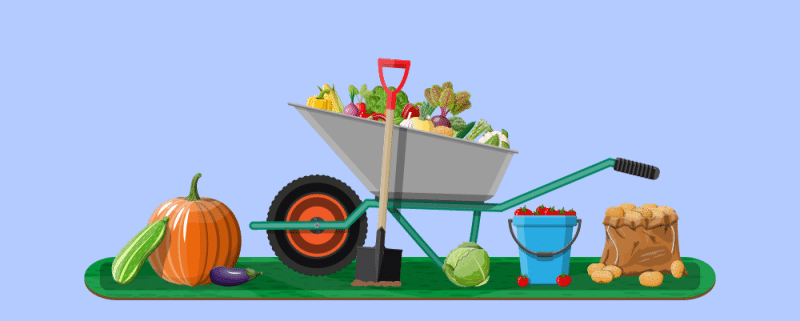
Gardening calendars are simply calendars that are designed specifically for gardening purposes. For gardeners, it’s a great idea to use a calendar dedicated to your plants. The reason for this is that it allows you to keep track of your planting schedule.
Certain vegetables should be planted in certain seasons. This is because they are the optimal seasons for planting them. As a result, you need to research the optimal planting season for a plant before you sow the seeds.
Moreover, different vegetables will take different amounts of time to germinate and mature. Some vegetables will be ready to harvest in 40 days, while others can take 100 days.
By marking these dates on the calendar, you can better know when your plants will be ready to harvest. As a result, you will take them out of the ground only when they have fully matured.
Whether you use a digital calendar or a physical one, this is essential for novice gardeners. One of the benefits of using a digital version is that you can set reminders so that you know when to water and harvest your magnificent vegetables. You can also include any other gardening jobs that you need to do, such as pruning.
Vegetable planning calendars work particularly well for beginners, as remembering all of these dates can be difficult. Not to mention, these calendars are an excellent tool for forgetful gardeners, as they will help them to stay on top of all of the vegetables that they’ve planted.
Choose Vegetables Suitable For Beginners

When you begin gardening, it’s important to think about what sort of plants you wish to grow. Specifically, you should focus on plants that will thrive in your garden. Some vegetables are harder to grow than others. For beginners, it’s best to avoid vegetables that are challenging to grow.
To make the most of your garden, it’s recommended that you begin with these 8 excellent vegetables:
Beets
Requiring minimal growing space, beets are super straightforward to grow. Another benefit for beginners is that beet won’t attract many pests or diseases. You also won't have to prepare the soil too much, as you can basically put the beets directly into the soil.
They usually take between 55 and 70 days to mature once planted. Beets are ideal for planting during the spring.
Carrots
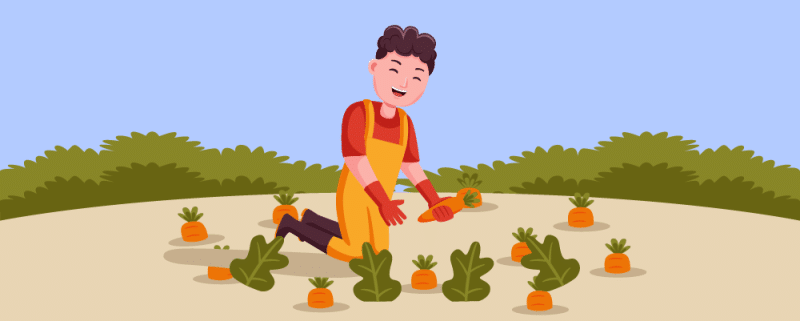
With a crunchy texture and vibrant orange hue, carrots are popular among gardeners. They can easily be sowed into the soil by making a seed drill. Just make sure that you choose the perfect patch for your carrots, as you will need plenty of sunlight and fertile soil.
Once you have planted the carrot seeds, they will start to germinate in just a few weeks. Carrots can be planted from spring to midsummer, ending around June or August. They can take a few weeks to grow but are incredibly easy to harvest. You should harvest your carrots when they are nice and long.
Cucumbers
Packed with antioxidants, cucumbers make a nutritious addition to salads and sandwiches. These tasty vegetables are also suitable for beginners, as they are fairly low-maintenance.
Cucumbers work best when grown in greenhouses, though they can also work well outdoors in spots with some shelter. The reason for this is that cucumbers need plenty of heat to germinate.
Cucumbers should be planted between April and June. However, if your greenhouse is warm, feel free to start earlier in the year. After planting, cucumbers usually take between 50 and 70 days to grow.
Green Beans
Green beans are a great addition to any garden, but they are particularly wonderful for beginners. They are also packed with vitamins, namely vitamins A and K.
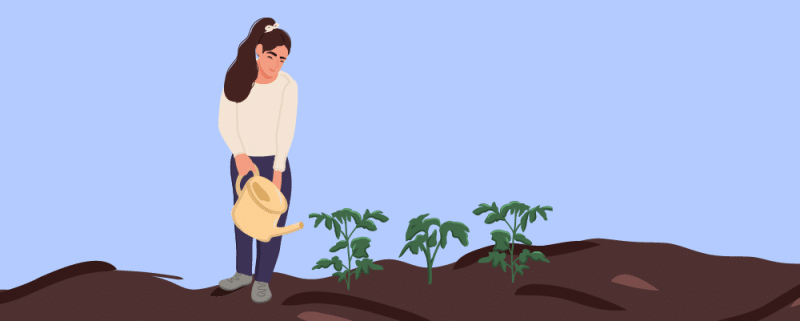
They are phenomenal for planting during the spring. In particular, late spring will be a good time to sow your green beans, as the frost will have disappeared by then. Green beans are not only suitable for growing outdoors, but they can also be grown indoors.
Lettuce
Lettuces are a staple of many people’s gardens. The reason for this is that lettuces are extremely versatile, as they can easily be added to burgers, sandwiches, and salads. There are lots of different types of lettuces, most of which are quite simple for starter gardeners.
You should sow your lettuce seeds in moist soil. You should find an area of soil that gets tons of sunlight. Just make sure that you give the seeds plenty of room to grow.
Radishes
Radishes have a strong taste that you either love or hate. But if you enjoy the flavor of these pink vegetables, they are an outstanding option for beginner gardeners. They are a wonderful way of making salads a little more flavorsome.
An additional benefit of radishes is that they can be harvested in just a few weeks. This is great for beginners who aren’t very patient.
Spinach
With a mild and somewhat sweet taste, spinach is a super source of vitamin K, folate, calcium, and Vitamin C. Spinach is super simple to prepare, so it makes a fantastic addition to a range of dishes.
This nutritious vegetable is straightforward to grow. It’s a hardy plant that is simple to sow and harvest, making it an outstanding vegetable for beginner gardeners.
Squash
The last vegetable that’s excellent for beginners is squash. In particular, butternut squash is a good choice for beginners, as it’s simple to grow. Around April is the ideal time for planting. It will take roughly 1 to 2 weeks for the squash to germinate.
Squash plants tend to enjoy lots of heat, so be sure to find a suitable patch of soil. It tends to be a relatively hardy vegetable, especially when compared to some of the other entries on this list. Make sure that your squash gets lots of water, as it thrives in moist and fertile soil.
Different Gardening Methods

Our last tip is to consider the various gardening methods that are available when planning your vegetable garden. Here are some of the best methods for vegetable gardens:
Mittleider Gardening Method
Based on science, the Mittleider gardening method encourages gardeners to maximize the yield of their pants with limited effort. Developed by Dr. Jacob Mittleider, this method is a great way of ensuring that plants get all of the nutrients that they need.
Click here if you want to find out more about the Mittleider gardening method.
Permaculture
Permaculture gardens aim to echo the natural cycle of life. For instance, food waste can be transformed into compost. This creates a garden that practically sustains itself. This is a great way of recycling and reducing waste. So if you want to grow an organic vegetable garden, permaculture may be the perfect method for you.
Hugelkultur
A hugelkultur is a form of raised bed used in gardening. This German concept uses waste to create these beds. Clipped branches, logs and other elements of natural waste can be used in this method to give your plants tons of nutrients.
No Dig Method
Most forms of gardening require lots of digging. But as the name indicates, the no-dig method will require minimal digging. For instance, hand weeding will be used to get rid of pesky weeds. The soil will be carefully cultivated to ensure the best environment for your vegetables.
Biodynamic Gardening
Biodynamic gardening is an organic and ethical process of growing plants. Biodynamic gardening is a holistic approach that can enrich the life of the gardener as well as the life of their plants.
Hydroponics
In hydroponics, plants will be used without soil. This sounds like a radical approach, but the truth is that hydroponics can be an effective method. Instead of using soil, water-based mineral nutrient salts and solutions will be utilized. This will require less water. But on the other hand, hydroponic gardening can be a rather time-consuming process for growing vegetables.
Summary
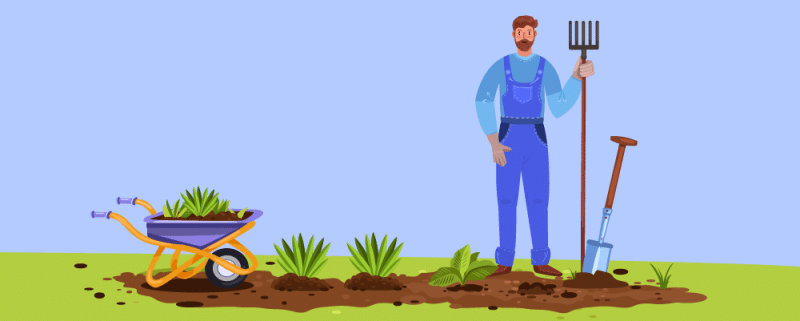
Gardening is an excellent hobby for anyone to take on. In particular, vegetable gardening is a rewarding activity that allows you to grow delicious plants that can add some nutrients and flavor to your dishes. Yet, it can be a difficult hobby to start, especially if you don’t know where to begin.
With this guide, green-thumbed individuals can begin their vegetable gardening journey. This guide gives you all the information that you need to know, including the best vegetables to grow for beginners.
So why not start growing vegetables in your garden? This could become your new favorite hobby!

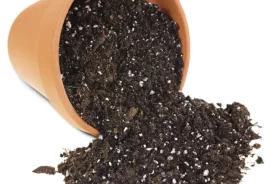
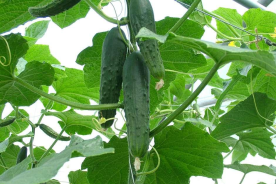
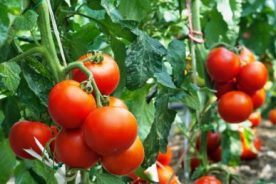

No Comments